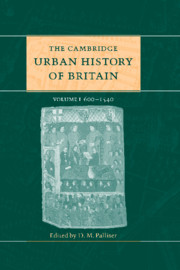Book contents
- Frontmatter
- Part I Introductory
- Part II The early middle ages 600–1300
- 3 General survey 600–1300
- 4 Power and authority 600–1300
- 5 Society and population 600–1300
- 6 The economy of British towns 600–1300
- 7 Churches, education and literacy in towns 600–1300
- 8 The topography of towns 600–1300
- 9 London from the post-Roman period to 1300
- 10 The large towns 600–1300
- 11 Small towns 600–1270
- Part III The later middle ages 1300–1540
- Part IV Regional surveys
- Part V Conclusion
- Appendix: Ranking lists of English medieval towns
- Select bibliography
- Index
- References
4 - Power and authority 600–1300
from Part II - The early middle ages 600–1300
Published online by Cambridge University Press: 28 March 2008
- Frontmatter
- Part I Introductory
- Part II The early middle ages 600–1300
- 3 General survey 600–1300
- 4 Power and authority 600–1300
- 5 Society and population 600–1300
- 6 The economy of British towns 600–1300
- 7 Churches, education and literacy in towns 600–1300
- 8 The topography of towns 600–1300
- 9 London from the post-Roman period to 1300
- 10 The large towns 600–1300
- 11 Small towns 600–1270
- Part III The later middle ages 1300–1540
- Part IV Regional surveys
- Part V Conclusion
- Appendix: Ranking lists of English medieval towns
- Select bibliography
- Index
- References
Summary
The exercise of power and authority in, through and over towns is fundamental to the evolution of the English state. State and towns were linked so intimately that the process or progress of each depended on the other.
power and authority in pre-conquest towns
Our earliest sources are suggestive, if meagre. A law of Hlothere and Eadric, kings of Kent (673 x 686), specifies: ‘If a man of Kent buys property in London he shall have two or three trustworthy men or the king's wicgerefa (wic reeve) as witness.’ The wic element relates to London as a major trading place; royal authority was already linked to the regulation of trade. Narrative sources put royal officials in the context of an urban site. Bede, writing c. 731 on Edwin of Northumbria (616–33), mentions a royal prefectus, obviously an important man, at Lincoln. A Life of Cuthbert (written 699 x 705) mentions civitatis praepositus at Carlisle in 685. Maybe such men exercised authority simply in a former Roman place, somewhat more probably in but chiefly from one. Such Roman centres could survive as centres of authority, if more doubtfully with other functions. Bede is explicit that Canterbury was the metropolis of the whole imperium of Æthelbert of Kent. London and York apparently enjoyed comparable status. The governmental status of some lesser places is attested by the names of early West Saxon shires. Hampshire (Hamtunscir, first mentioned s. a. 755 in the Chronicle, composed c. 891) takes its name from Hamtun, the royal centre at or near modern Southampton.
- Type
- Chapter
- Information
- The Cambridge Urban History of Britain , pp. 51 - 78Publisher: Cambridge University PressPrint publication year: 2000
References
- 1
- Cited by



